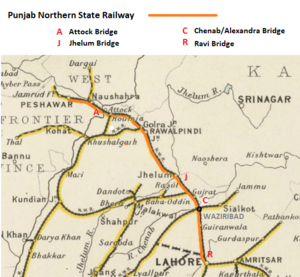Jhelum Bridge: Difference between revisions
Google widget added |
mNo edit summary |
||
| (3 intermediate revisions by the same user not shown) | |||
| Line 1: | Line 1: | ||
'''Jhelum Bridge''' | '''Jhelum Bridge''' | ||
The | The bridge opened 14 Sep 1876 as metre gauge([[Rail_gauge_#Metre_Gauge|MG]]) ‘[[Punjab Northern State Railway]]’(PNSR) connecting [[Lahore]] to [[Jhelum]]. The bridge was composed of iron trusses over many concrete piers. It has single railway track and a road on one side of the track. | ||
<ref>[https://en.wikipedia.org/wiki/History_of_Jhelum Wikipedia "History of Jhelum"]; Retrieved on ... | |||
[[File: Punjab Northern State Railway v1.png|thumb| Punjab Northern State Railway]] | |||
The PNSR with three associated bridges, was the first attempt of railway construction under the newly formed [[Railway_Branch_-_PWD|Public Works Department - Railway Branch]]. | |||
The bridges were :- | |||
* [[Alexandra Bridge| ‘Chenab / Alexandra Bridge’]] over the River Chenab - shown as '''C''' on map | |||
* ‘[[Jhelum Bridge]]’, over the River Jhelum - shown as '''J''' on map | |||
* ‘[[Ravi Bridge]]’, over the River Ravi- shown as '''R''' on map | |||
==Construction== | |||
The bridge was constructed by the PNSR in accordance with Government Railway Gauge policy at the time [[Rail_gauge#Gauge_Question|(''See separate page ‘Railway Gauge’ '')]]. This policy was reversed in Jan 1874 and the conversion of this section to broad gauge([[Rail_gauge#Broad_Gauge|BG]]) was completed in 1878 | |||
[[Jhelum]] was then connected by other cities in the Indian empire, 1,367 miles(2190km) from [[Calcutta]], 1,413 miles(2260km) from [[Bombay]], and 849 miles(1360km) from [[Karachi]]. | |||
<ref>[https://en.wikipedia.org/wiki/History_of_Jhelum#British_era Wikipedia "History of Jhelum"]; Retrieved on 15 Nov 2020</ref>. | |||
The PNSR was merged with other railways to form the ‘[[North Western Railway]]’(NWR) in 1886 | |||
==Construction== | |||
The construction of the railway bridge on the river Jhelum commenced in 1873 by the British engineer [[William St. John Galwey]] and assisted by the young engineer [[Hugh Lewin Monk]]. The length of the bridge was fixed at 4875 feet(1486mtr) between the abutments with training works of the left bank. There are 50 spans of 90 feet (27.4mtr) each giving forty-nine piers and two abutments. | |||
The details of the construction are fully given in the ‘Proceedings of the Institution of Civil Engineers, 1878’ <ref>[http://www.icevirtuallibrary.com/doi/abs/10.1680/imotp.1878.22418?src=recsys ‘Minutes of the Proceedings of the Institution of Civil Engineers’ Volume 54 Issue 1878, 1878, pp. 94-107"]; Retrieved on 15 Nov 2020</ref>. | |||
==Present State== | |||
This bridge is still used by railway and road traffic. It is the longest Railway Bridge of Pakistan spanning across length of 2.6 miles (4.225 km) <ref>[https://en.wikipedia.org/wiki/Jhelum_Bridge Wikipedia "Jhelum Bridge"]; Retrieved on 15 Nov 2020</ref>. | |||
==Further Information== | |||
See '''[[Punjab Northern State Railway]] ''' for information and map showing location of ‘Attock Bridge’ and other PNSR Bridges | |||
<br>and '''[[North Western Railway]]''' for information after 1886 | |||
== References == | == References == | ||
<references /> | <references /> | ||
[[Category:Railways]] | [[Category:Railways]] | ||
[[Category:Railway Constructions]] | [[Category:Railway Constructions]] | ||
Latest revision as of 12:45, 27 November 2020
Jhelum Bridge
The bridge opened 14 Sep 1876 as metre gauge(MG) ‘Punjab Northern State Railway’(PNSR) connecting Lahore to Jhelum. The bridge was composed of iron trusses over many concrete piers. It has single railway track and a road on one side of the track.

The PNSR with three associated bridges, was the first attempt of railway construction under the newly formed Public Works Department - Railway Branch.
The bridges were :-
- ‘Chenab / Alexandra Bridge’ over the River Chenab - shown as C on map
- ‘Jhelum Bridge’, over the River Jhelum - shown as J on map
- ‘Ravi Bridge’, over the River Ravi- shown as R on map
Construction
The bridge was constructed by the PNSR in accordance with Government Railway Gauge policy at the time (See separate page ‘Railway Gauge’ ). This policy was reversed in Jan 1874 and the conversion of this section to broad gauge(BG) was completed in 1878
Jhelum was then connected by other cities in the Indian empire, 1,367 miles(2190km) from Calcutta, 1,413 miles(2260km) from Bombay, and 849 miles(1360km) from Karachi. [1].
The PNSR was merged with other railways to form the ‘North Western Railway’(NWR) in 1886
Construction
The construction of the railway bridge on the river Jhelum commenced in 1873 by the British engineer William St. John Galwey and assisted by the young engineer Hugh Lewin Monk. The length of the bridge was fixed at 4875 feet(1486mtr) between the abutments with training works of the left bank. There are 50 spans of 90 feet (27.4mtr) each giving forty-nine piers and two abutments.
The details of the construction are fully given in the ‘Proceedings of the Institution of Civil Engineers, 1878’ [2].
Present State
This bridge is still used by railway and road traffic. It is the longest Railway Bridge of Pakistan spanning across length of 2.6 miles (4.225 km) [3].
Further Information
See Punjab Northern State Railway for information and map showing location of ‘Attock Bridge’ and other PNSR Bridges
and North Western Railway for information after 1886
References
- ↑ Wikipedia "History of Jhelum"; Retrieved on 15 Nov 2020
- ↑ ‘Minutes of the Proceedings of the Institution of Civil Engineers’ Volume 54 Issue 1878, 1878, pp. 94-107"; Retrieved on 15 Nov 2020
- ↑ Wikipedia "Jhelum Bridge"; Retrieved on 15 Nov 2020